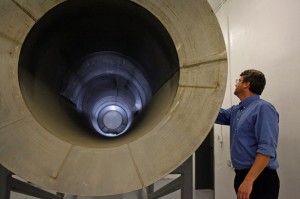New aviation and automotive facility opens for classes
August 21, 2012
Students crowded maps of the new 228,000 square foot Transportation Education Center Monday as they searched for classroom locations the first day of the semester.
Finishing touches are being made to the new TEC facility, which has been under construction since 2010 and a goal for transportation program leaders since the ‘90s.
Located at Southern Illinois Airport, the center will house the University’s automotive programs, which were formerly held on the 60-year-old Carterville campus. It will also serve the aviation technology and aviation management and flight programs.
Advertisement
About 660 students started class this week at the center, said David NewMyer, chair of the aviation management and flight program.
“It will be great once everybody gets over the being-lost part and gets to the point of what the building can do for them,” he said.
The project was originally expected to cost $52 million to build, NewMyer said, but it cost $43 million because of low bids from construction companies from the recession.
Because the entire project was funded through state capital development funds, the $9 million difference will be put into equipment.
“With that money we’re going to get some good stuff,” NewMyer said.
The center will replace the use of six buildings from the Carterville campus and two buildings at the airport.
“A lot of people think we’re abandoning everything on the airport,” he said. “That’s not true.”
Advertisement*
Of the six buildings SIU uses on the airport campus, two will be abandoned.
A few features of the 185,000 square foot main building are a library, flight simulators, three automotive technology labs, classrooms, training labs to simulate an airport tower, a large space for conference room or events, and faculty and staff offices.
Flight simulators, which cost about $250,000 when fully assembled, will also help save money by cutting gas expenses. The simulators will display the southern Illinois and St. Louis area so students can get the chance to use the machines before they navigate the skies in flight.
“It’s a big step up for us,” NewMyer said. “We don’t do anything like that now.”
Aviation opportunities
In addition to the flight simulation center is what NewMyer called the hub for the flight program — the weather dispatch center. Student workers at the center’s desk give students their keys, fuel cards and information to check them into flights through a computer system as well as monitor area weather reports.
Much of the process was previously done through physical paperwork, NewMyer said.
“We have a hangar full of charts,” he said.
David Bias, a senior from Chicago studying aviation flight and management, was available to students Monday at weather dispatch.
“It’s almost like an airport terminal,” he said. “It will show you who is on the schedule, what time they’re flying, what’s their destination.”
While the largest TEC building houses three automotive technology labs as well as faculty and staff offices, classrooms, the flight simulation and weather dispatch centers, another is the test cell.
“It’s for running engines in a very scientific way,” said Mike Burgener, chair of aviation technologies. “It gives us the opportunity to run an engine in an infinite number of ways.”
The test cell includes four individual rooms where students can measure engine functions. While students work with the engines in the cell, a classroom serves as an area where others can observe from a window to the test cell.
“Before, if we wanted to run an engine we just ran it on the engine on the aircraft,” Burgener said. “This is exactly what you need in order to do high-level research. It’s really a great learning environment for the students as well.”
He said this is the only place in southern Illinois with the test cell technology.
One of the larger test cells is designed for jet engines. A 25-foot long tunnel takes exhaust from the engine up to the roof. The cell is soundproof.
“This is the exact same type of technology (students) would see in industry,” Burgener said.
Automotive technologies
Back in the main building, the three automotive service labs are each dedicated toward different areas of the vehicle, Mike Behrmann, chair of automotive technologies, said.
The classrooms include equipment to do diagnostics and demonstrations on engines while students sit in class. Between the labs is a retail parts store where students can buy supplies for classes.
Behrmann said the technologies are needed in order to help students prepare for their field.
“This is the nation’s premier automotive training program,” he said. “Our graduates are in extremely high demand … I’ve by far got more jobs than I do contacts.”
A New Home
Behrmann said about 30 semi-loads of equipment and supplies and 95 training vehicles were towed to the center and are still being moved in from the campus in Carterville.
The former campus was partially housed in old army barracks.
Andrew Putz, a senior from Troy studying automotive technology, said the former facilities had holes in the wall and grass growing into the buildings.
“It was pretty dated,” he said.
What he said he’s enjoyed most about the new facility this week is the availability of the 120 new computers and air conditioning. Once all of the equipment is in place, he said he looks forward to working in the classrooms with hands-on demonstration areas for engine repairs.
“And it’s awesome to be one of the first groups to be able to use this,” he said.
Behrmann said the tentative date for the grand opening is Oct. 26, when tours of the facility will be given.
“The craftspeople of southern Illinois have really built a beautiful facility, he said. “After 60 years of being on the Carterville campus, this is our new home.”
Advertisement








